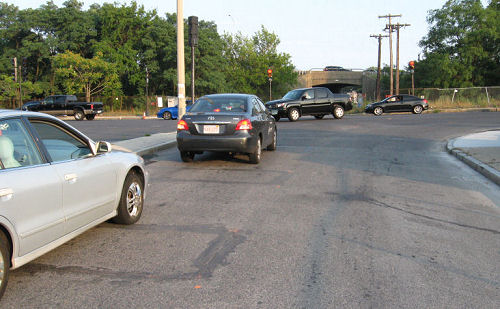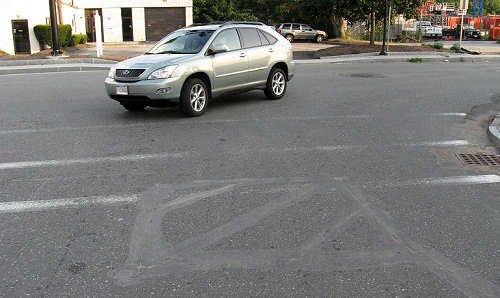Boston has been installing traffic-signal actuator loops that don’t work for bicyclists, and sometimes not even for motorists.
Installing the right kind of loops doesn’t cost any more — it’s merely a question of cutting a different set of slots in the pavement and laying a different pattern of wires in those slots.
Traffic signal actuator loops are, very simply, metal detectors — radio antennas buried just below the surface of the street, sending out a radio signal which is disturbed when a metal object appears overhead. The radio transmitter senses the different loading and triggers the traffic signal.
The older loop pattern — a plain square or rectangle — has a lot of signal spillage. The sensitivity has to be reduced to prevent triggering by vehicles in the wrong lane. The actuator then often does not respond to a bicycle or motorcycle. You can sometimes trigger it by placing your wheels over the wire at one side.
The newer type, with two rectangles side by side in a lane or a diagonal pattern, has very little spillage, and so its sensitivity can be increased. A metallic bicycle rim or frame should be able to trigger one of these. Same for a loop of very thin wire inside the perimeter of a carbon-fiber rim or frame…which in my opinion should be required equipment. For more information, you may read see my article about actuators, — and the other articles it links to.
Last year, Boston installed traffic signal actuator loops in Scuocco Square (Cambridge Street and New Chardon Street/Bowdoin Street). These actuators were of the type that is supposed to detect bicycles but the wires were placed incorrectly. Even a motor vehicle wouldn’t trigger one of these actuators, because the loop is after the stop bar. See photos. I reported the problem to a Boston city official in a position of responsibility to resolve the problem.
This summer, Boston installed actuator loops in Allston, at the intersections of Cambridge Street with Lincoln Street and North Harvard Street. These are not even the bicycle-sensitive type. Not only that, the ones on Lincoln Street are only in the left lane. A motor vehicle in the right lane could make a right turn on red but, unless another motor vehicle pulls alongside in the left lane, the traffic light will not turn green and there will be no safe or legal way to cross the seven lanes of Cambridge Street to the Turnpike underpass on the opposite side. See photos.
A few minutes before I discovered the Allston installation, I rode over a perfect, new bicycle-sensitive loop installation in Watertown, at the intersection of Rosedale Road and Pleasant Street. If Watertown can get this right, why not Boston?
I discovered these installations only by happenstance. I am quite sure that there are other examples, both good and bad. Please feel free to report them. Comments are open.



Wow! Where was the Mayor’s Bike Program on that one? Asleep at the wheel, er, no, working frantically at instituting its foolish bike share program and missing these easy opportunities to make it easier and safe for riders. Join the club!
I noticed that when comm ave was redone 2 years ago, signs went up telling cyclists to request green by stopping on the loop….but as far as I could see, no loops had been installed. Usually, theyre pretty obvious
I haven’t checked out Comm. Ave. but keep in mind that the stretch between Kenmore Square and the BU Bridge was repaved. Loops may have been installed before the final layer of pavement was laid down. If you can trigger the signal by waiting over the marking, then the installation was correct. On a busy street like Comm. Ave., you might have to try this in the early hours of the morning so you know that a car didn’t trigger the signal. A poor installation on a quiet side street is most likely to leave you facing a red light, and with heavy traffic on the main street in crosses.
As Bicycle Program Manager for Boston, I saw the problem with the Cambridge Street loop detectors and tried to bring the issue to the attention of Para Jayasingh, the City’s Chief Engineer. He yelled at me for wanting to change the plans and refused to listen to my concern.
The City’s policy is to install the lead loop 20 feet from the curb line extended, even if that is under or even beyond the crosswalk (to permit red-light runners to trigger the loop). The state’s policy requires only the lead loop to be sensitive. Therein the problem. There are more.